check engine YAMAHA XMAX 125 2021 Owner's Manual
[x] Cancel search | Manufacturer: YAMAHA, Model Year: 2021, Model line: XMAX 125, Model: YAMAHA XMAX 125 2021Pages: 114, PDF Size: 13.55 MB
Page 80 of 114
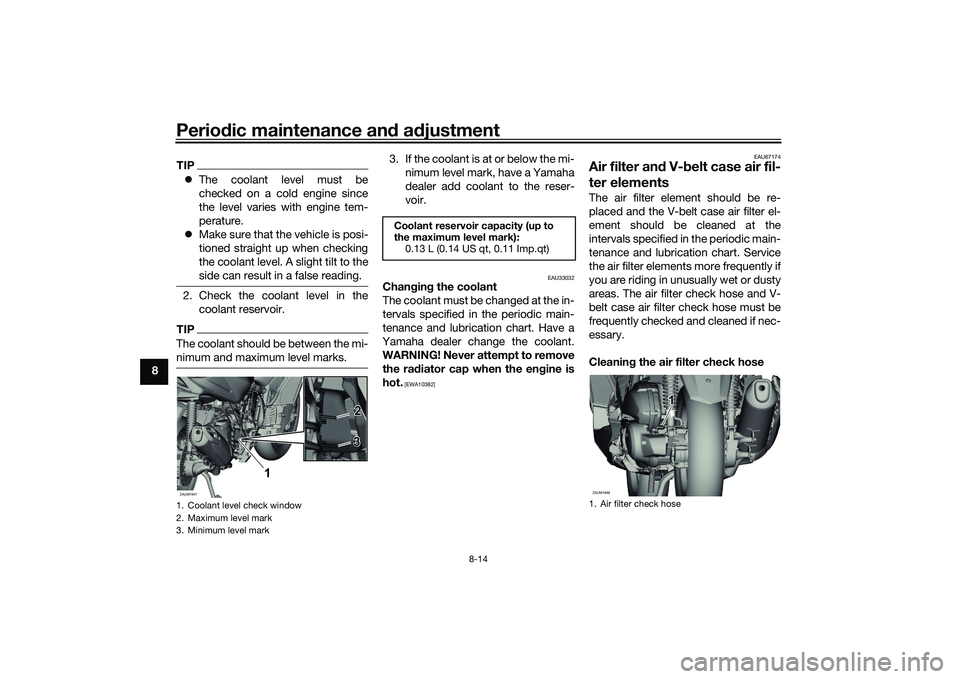
Periodic maintenance an d a djustment
8-14
8
TIP The coolant level must be
checked on a cold engine since
the level varies with engine tem-
perature.
Make sure that the vehicle is posi-
tioned straight up when checking
the coolant level. A slight tilt to the
side can result in a false reading.2. Check the coolant level in the
coolant reservoir.TIPThe coolant should be between the mi-
nimum and maximum level marks.
3. If the coolant is at or below the mi-nimum level mark, have a Yamaha
dealer add coolant to the reser-
voir.
EAU33032
Chan gin g the coolant
The coolant must be changed at the in-
tervals specified in the periodic main-
tenance and lubrication chart. Have a
Yamaha dealer change the coolant.
WARNING! Never attempt to remove the ra diator cap when the en gine is
hot.
[EWA10382] EAU67174
Air filter an
d V- belt case air fil-
ter elementsThe air filter element should be re-
placed and the V-belt case air filter el-
ement should be cleaned at the
intervals specified in the periodic main-
tenance and lubrication chart. Service
the air filter elements more frequently if
you are riding in unusually wet or dusty
areas. The air filter check hose and V-
belt case air filter check hose must be
frequently checked and cleaned if nec-
essary.
Cleanin g the air filter check hose
1. Coolant level check window
2. Maximum level mark
3. Minimum level markZAUM1947
1 2
2
3 2
3
Coolant reservoir capacity (up to
the maximum level mark): 0.13 L (0.14 US qt, 0.11 Imp.qt)
1. Air filter check hoseZAUM1948
1 11
UB9YE0E0.book Page 14 Wednesday, January 6, 2021 3:03 PM
Page 83 of 114
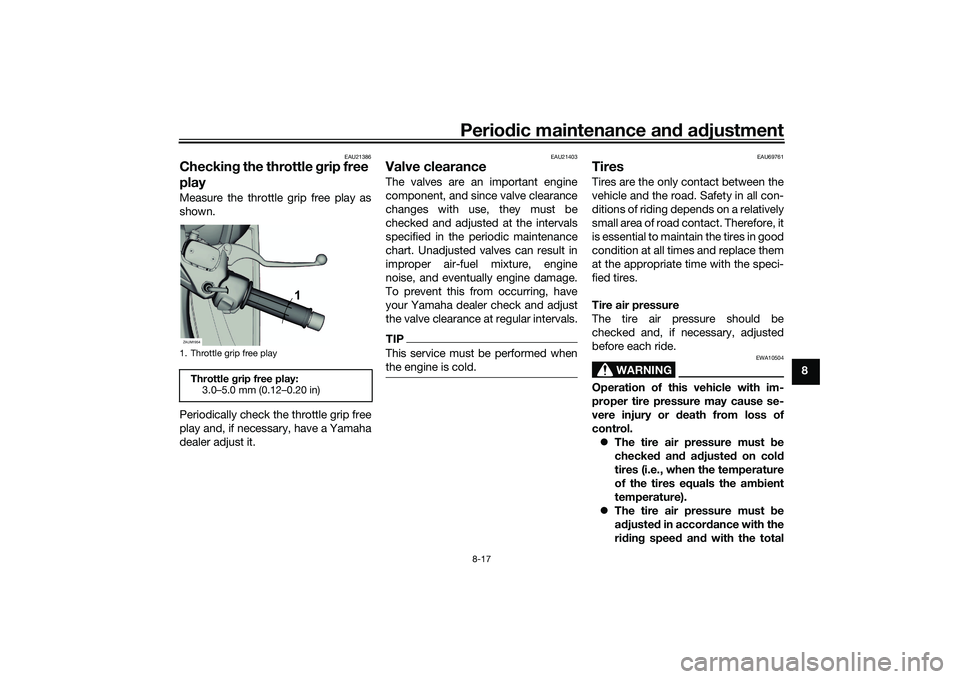
Periodic maintenance an d a djustment
8-17
8
EAU21386
Checkin g the throttle grip free
playMeasure the throttle grip free play as
shown.
Periodically check the throttle grip free
play and, if necessary, have a Yamaha
dealer adjust it.
EAU21403
Valve clearanceThe valves are an important engine
component, and since valve clearance
changes with use, they must be
checked and adjusted at the intervals
specified in the periodic maintenance
chart. Unadjusted valves can result in
improper air-fuel mixture, engine
noise, and eventually engine damage.
To prevent this from occurring, have
your Yamaha dealer check and adjust
the valve clearance at regular intervals.TIPThis service must be performed when
the engine is cold.
EAU69761
TiresTires are the only contact between the
vehicle and the road. Safety in all con-
ditions of riding depends on a relatively
small area of road contact. Therefore, it
is essential to maintain the tires in good
condition at all times and replace them
at the appropriate time with the speci-
fied tires.
Tire air pressure
The tire air pressure should be
checked and, if necessary, adjusted
before each ride.
WARNING
EWA10504
Operation of this vehicle with im-
proper tire pressure may cause se-
vere injury or d eath from loss of
control. The tire air pressure must be
checked and a djuste d on col d
tires (i.e., when the temperature
of the tires equals the am bient
temperature).
The tire air pressure must be
a d juste d in accor dance with the
ri din g spee d an d with the total
1. Throttle grip free playThrottle grip free play:
3.0–5.0 mm (0.12–0.20 in)ZAUM1954
1
UB9YE0E0.book Page 17 Wednesday, January 6, 2021 3:03 PM
Page 97 of 114
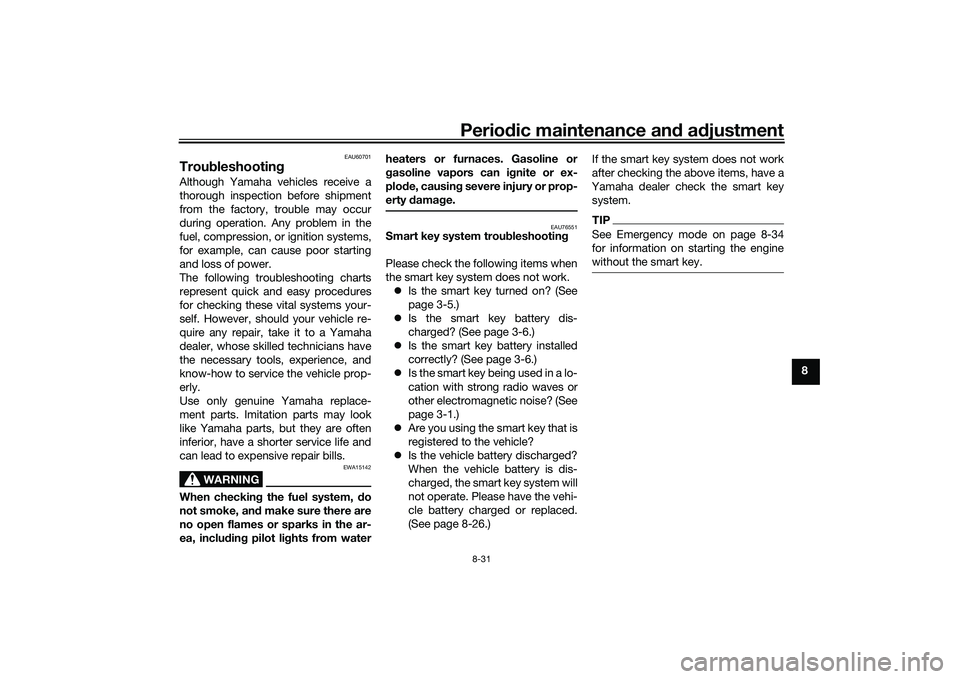
Periodic maintenance an d a djustment
8-31
8
EAU60701
Trou bleshootin gAlthough Yamaha vehicles receive a
thorough inspection before shipment
from the factory, trouble may occur
during operation. Any problem in the
fuel, compression, or ignition systems,
for example, can cause poor starting
and loss of power.
The following troubleshooting charts
represent quick and easy procedures
for checking these vital systems your-
self. However, should your vehicle re-
quire any repair, take it to a Yamaha
dealer, whose skilled technicians have
the necessary tools, experience, and
know-how to service the vehicle prop-
erly.
Use only genuine Yamaha replace-
ment parts. Imitation parts may look
like Yamaha parts, but they are often
inferior, have a shorter service life and
can lead to expensive repair bills.
WARNING
EWA15142
When checkin g the fuel system, d o
not smoke, an d make sure there are
no open flames or sparks in the ar-
ea, inclu din g pilot li ghts from water heaters or furnaces. Gasoline or
g
asoline vapors can i gnite or ex-
plo de, causin g severe injury or prop-
erty damag e.
EAU76551
Smart key system trou bleshootin g
Please check the following items when
the smart key system does not work. Is the smart key turned on? (See
page 3-5.)
Is the smart key battery dis-
charged? (See page 3-6.)
Is the smart key battery installed
correctly? (See page 3-6.)
Is the smart key being used in a lo-
cation with strong radio waves or
other electromagnetic noise? (See
page 3-1.)
Are you using the smart key that is
registered to the vehicle?
Is the vehicle battery discharged?
When the vehicle battery is dis-
charged, the smart key system will
not operate. Please have the vehi-
cle battery charged or replaced.
(See page 8-26.) If the smart key system does not work
after checking the above items, have a
Yamaha dealer check the smart key
system.
TIPSee Emergency mode on page 8-34
for information on starting the engine
without the smart key.
UB9YE0E0.book Page 31 Wednesday, January 6, 2021 3:03 PM
Page 98 of 114
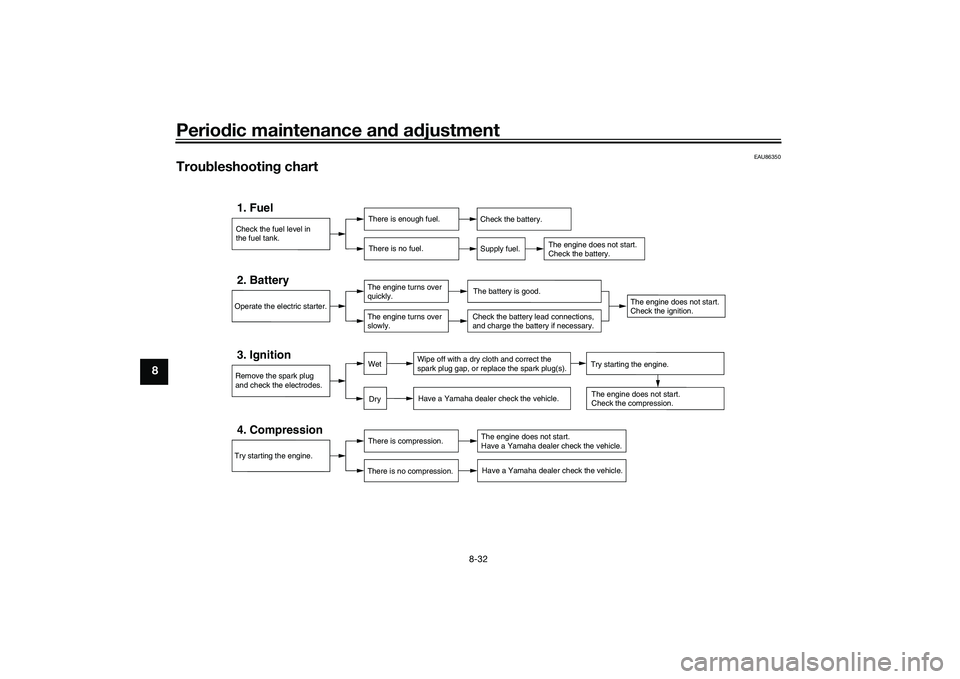
Periodic maintenance an d a djustment
8-32
8
EAU86350
Trou bleshootin g chart
Check the fuel level in
the fuel tank.1. Fuel
There is enough fuel.
There is no fuel.
Check the battery.
Supply fuel.
The engine does not start.
Check the battery.
Try starting the engine.4. Compression
There is compression.
There is no compression.
The engine does not start.
Have a Yamaha dealer check the vehicle.Have a Yamaha dealer check the vehicle.
Remove the spark plug
and check the electrodes.3. Ignition
Wipe off with a dry cloth and correct the
spark plug gap, or replace the spark plug(s). Have a Yamaha dealer check the vehicle.
The engine does not start.
Check the compression.
Operate the electric starter.2. Battery
The engine turns over
quickly.
The engine turns over
slowly.
The battery is good.
DryWet
Try starting the engine.
Check the battery lead connections,
and charge the battery if necessary.
The engine does not start.
Check the ignition.
UB9YE0E0.book Page 32 Wednesday, January 6, 2021 3:03 PM
Page 99 of 114

Periodic maintenance an d a djustment
8-33
8
EAU86420
En gine overheatin g
WARNING
EWAT1041
Do not remove the ra diator cap when the en gine an d ra diator are hot. Scal din g hot flui d an d steam may be
b lown out un der pressure, which coul d cause serious injury. Be sure to wait until the en gine has coole d.
Place a thick ra g, like a towel, over the ra diator cap, an d then slowly rotate the cap counterclockwise to the
d etent to allow any resi dual pressure to escape. When the hissin g soun d has stoppe d, press down on the cap
while turnin g it counterclockwise, an d then remove the cap.TIPIf coolant is not available, tap water can be temporarily used instead, provided that it is changed to the recommended cool-
ant as soon as possible.
Wait until the
engine has cooled.
Check the coolant level in the
reservoir and radiator.
The coolant level
is OK.The coolant level is low.
Check the cooling system
for leakage.
Have a Yamaha dealer checkand repair the cooling system.Add coolant. (See TIP.)
Start the engine. If the engine overheats again,
have a
Yamaha dealer check
and repair the cooling system.
There is
leakage.
There is
no leakage.
UB9YE0E0.book Page 33 Wednesday, January 6, 2021 3:03 PM
Page 105 of 114
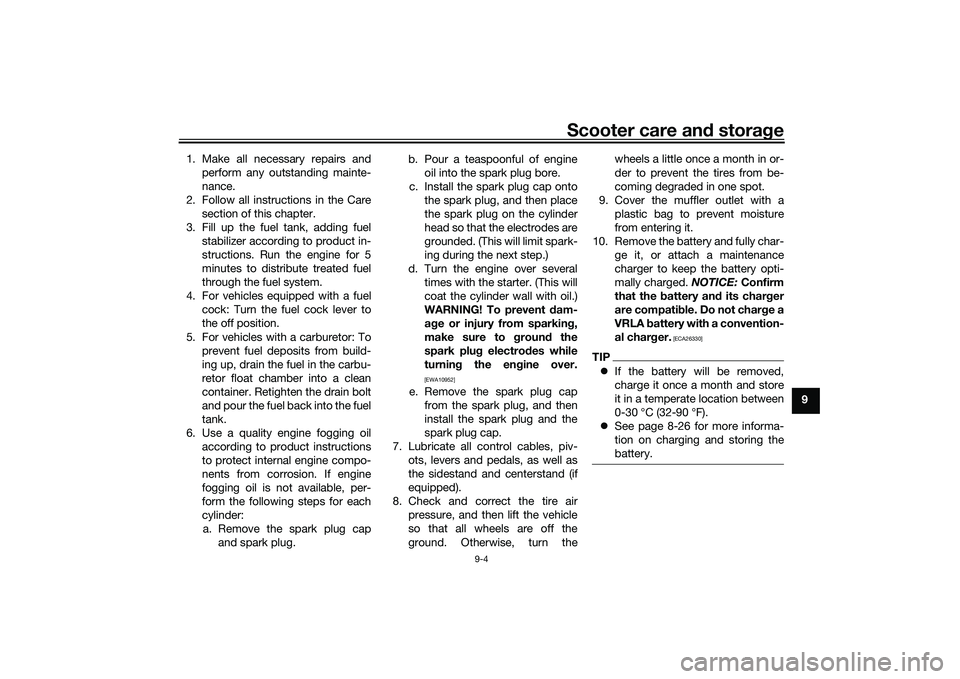
Scooter care and stora ge
9-4
9
1. Make all necessary repairs and
perform any outstanding mainte-
nance.
2. Follow all instructions in the Care section of this chapter.
3. Fill up the fuel tank, adding fuel stabilizer according to product in-
structions. Run the engine for 5
minutes to distribute treated fuel
through the fuel system.
4. For vehicles equipped with a fuel cock: Turn the fuel cock lever to
the off position.
5. For vehicles with a carburetor: To prevent fuel deposits from build-
ing up, drain the fuel in the carbu-
retor float chamber into a clean
container. Retighten the drain bolt
and pour the fuel back into the fuel
tank.
6. Use a quality engine fogging oil according to product instructions
to protect internal engine compo-
nents from corrosion. If engine
fogging oil is not available, per-
form the following steps for each
cylinder:a. Remove the spark plug cap and spark plug. b. Pour a teaspoonful of engine
oil into the spark plug bore.
c. Install the spark plug cap onto the spark plug, and then place
the spark plug on the cylinder
head so that the electrodes are
grounded. (This will limit spark-
ing during the next step.)
d. Turn the engine over several times with the starter. (This will
coat the cylinder wall with oil.)
WARNING! To prevent dam-
a g e or injury from sparkin g,
make sure to groun d the
spark plu g electro des while
turnin g the en gine over.
[EWA10952]
e. Remove the spark plug cap
from the spark plug, and then
install the spark plug and the
spark plug cap.
7. Lubricate all control cables, piv- ots, levers and pedals, as well as
the sidestand and centerstand (if
equipped).
8. Check and correct the tire air pressure, and then lift the vehicle
so that all wheels are off the
ground. Otherwise, turn the wheels a little once a month in or-
der to prevent the tires from be-
coming degraded in one spot.
9. Cover the muffler outlet with a plastic bag to prevent moisture
from entering it.
10. Remove the battery and fully char- ge it, or attach a maintenance
charger to keep the battery opti-
mally charged. NOTICE: Confirm
that the battery an d its char ger
are compati ble. Do not char ge a
VRLA battery with a convention-
al char ger.
[ECA26330]
TIP If the battery will be removed,
charge it once a month and store
it in a temperate location between
0-30 °C (32-90 °F).
See page 8-26 for more informa-
tion on charging and storing the
battery.
UB9YE0E0.book Page 4 Wednesday, January 6, 2021 3:03 PM
Page 109 of 114

Consumer information
11-2
11
The model label is affixed to the inside
of the rear storage compartment. (See
page 5-20.) Record the information on
this label in the space provided. This
information will be needed when order-
ing spare parts from a Yamaha dealer.
EAU69910
Dia
gnostic connectorThe diagnostic connector is located as
shown.
EAU85300
Vehicle data recor din gThis model’s ECU stores certain vehi-
cle data to assist in the diagnosis of
malfunctions and for research, statisti-
cal analysis and development purpos-
es.
Although the sensors and recorded
data will vary by model, the main data
points are:
Vehicle status and engine perfor-
mance data
Fuel-injection and emission-relat-
ed data
This data will be uploaded only when a
special Yamaha diagnostic tool is at-
tached to the vehicle, such as when
maintenance checks or service proce-
dures are performed.
Vehicle data uploaded will be handled
appropriately according to the follow-
ing Privacy Policy.
Privacy Policy
1. Diagnostic connectorZAUM1976
1 1
1
https://www.yamaha-motor.eu/eu/
privacy/privacy-policy.aspx
UB9YE0E0.book Page 2 Wednesday, January 6, 2021 3:03 PM
Page 111 of 114
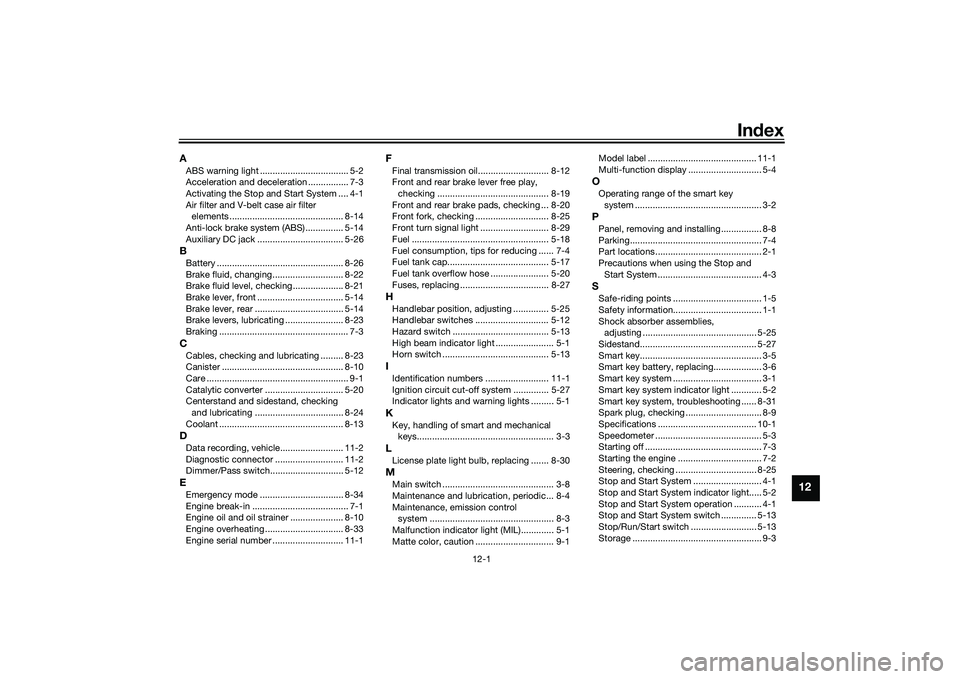
12-1
12
Index
AABS warning light ................................... 5-2
Acceleration and deceleration ................ 7-3
Activating the Stop and Start System .... 4-1
Air filter and V-belt case air filter
elements ............................................. 8-14
Anti-lock brake system (ABS)............... 5-14
Auxiliary DC jack .................................. 5-26BBattery .................................................. 8-26
Brake fluid, changing............................ 8-22
Brake fluid level, checking.................... 8-21
Brake lever, front .................................. 5-14
Brake lever, rear ................................... 5-14
Brake levers, lubricating ....................... 8-23
Braking ................................................... 7-3CCables, checking and lubricating ......... 8-23
Canister ................................................ 8-10
Care ........................................................ 9-1
Catalytic converter ............................... 5-20
Centerstand and sidestand, checking and lubricating ................................... 8-24
Coolant ................................................. 8-13DData recording, vehicle......................... 11-2
Diagnostic connector ........................... 11-2
Dimmer/Pass switch............................. 5-12EEmergency mode ................................. 8-34
Engine break-in ...................................... 7-1
Engine oil and oil strainer ..................... 8-10
Engine overheating ............................... 8-33
Engine serial number ............................ 11-1
FFinal transmission oil............................ 8-12
Front and rear brake lever free play, checking ............................................ 8-19
Front and rear brake pads, checking ... 8-20
Front fork, checking ............................. 8-25
Front turn signal light ........................... 8-29
Fuel ...................................................... 5-18
Fuel consumption, tips for reducing ...... 7-4
Fuel tank cap........................................ 5-17
Fuel tank overflow hose ....................... 5-20
Fuses, replacing ................................... 8-27HHandlebar position, adjusting .............. 5-25
Handlebar switches ............................. 5-12
Hazard switch ...................................... 5-13
High beam indicator light ....................... 5-1
Horn switch .......................................... 5-13IIdentification numbers ......................... 11-1
Ignition circuit cut-off system .............. 5-27
Indicator lights and warning lights ......... 5-1KKey, handling of smart and mechanical keys...................................................... 3-3LLicense plate light bulb, replacing ....... 8-30MMain switch ............................................ 3-8
Maintenance and lubrication, periodic... 8-4
Maintenance, emission control system ................................................. 8-3
Malfunction indicator light (MIL)............. 5-1
Matte color, caution ............................... 9-1 Model label ........................................... 11-1
Multi-function display ............................. 5-4
OOperating range of the smart key
system .................................................. 3-2PPanel, removing and installing ................ 8-8
Parking.................................................... 7-4
Part locations.......................................... 2-1
Precautions when using the Stop and Start System ......................................... 4-3SSafe-riding points ................................... 1-5
Safety information................................... 1-1
Shock absorber assemblies, adjusting ............................................. 5-25
Sidestand.............................................. 5-27
Smart key................................................ 3-5
Smart key battery, replacing................... 3-6
Smart key system ................................... 3-1
Smart key system indicator light ............ 5-2
Smart key system, troubleshooting ...... 8-31
Spark plug, checking .............................. 8-9
Specifications ....................................... 10-1
Speedometer .......................................... 5-3
Starting off .............................................. 7-3
Starting the engine ................................. 7-2
Steering, checking ................................ 8-25
Stop and Start System ........................... 4-1
Stop and Start System indicator light..... 5-2
Stop and Start System operation ........... 4-1
Stop and Start System switch .............. 5-13
Stop/Run/Start switch .......................... 5-13
Storage ................................................... 9-3
UB9YE0E0.book Page 1 Wednesday, January 6, 2021 3:03 PM